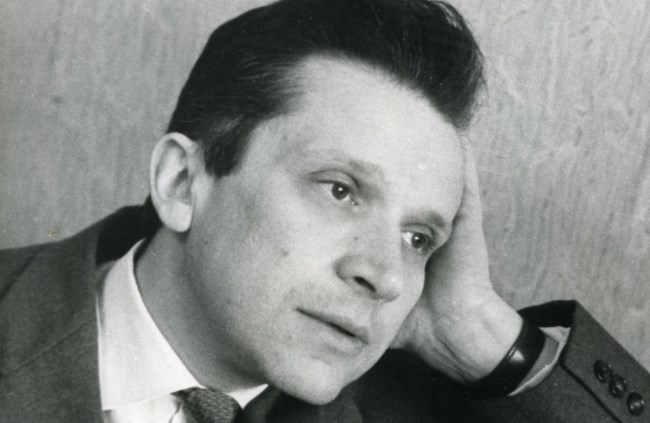Mieczysław Weinberg, Symphony No. 5
By Peter Laki
Born December 8, 1919, in Warsaw, Poland
Died February 26, 1996, in Moscow, Russia
Composed in 1962
Premiered on October 18, 1962, in Moscow by the Moscow Symphony, conducted by Kirill Kondrashin
Performance Time: Approximately 42 minutes
Weinberg’s Fifth Symphony may be seen as the composer’s response to Shostakovich’s Fourth, which was first performed publicly in 1961, 25 years after it was written. Weinberg had been familiar with the work long before the official premiere, as he and Shostakovich had played it through on two pianos, for an invited audience, as early as 1946. The Fourth is one of Shostakovich’s boldest creations, using modernistic means to convey a rather bleak artistic vision. That is where Weinberg took his cue (the allusion is particularly clear at the end of the symphony), although he also incorporated lessons learned from Shostakovich’s more classically oriented Fifth Symphony.
Shostakovich and Weinberg were among a mere handful of composers in the 1960s who still believed that the symphony, with its capacity to express and reconcile sharp musical and emotional contrasts, was still a viable genre with plenty of unrealized potential. Weinberg wrote no fewer than 22 symphonies over the years (leaving the last one unfinished at the time of his death). The Mahlerian concept of the symphony as an all-embracing mirror of human experience proved particularly relevant in the Soviet Union where there was so much human suffering to process. And Weinberg, as David Fanning pointed out in his biography of the composer, took up the torch from Shostakovich at a time when the latter’s symphonic production began to slow down after his monumental No. 13 (“Babi Yar”). These were also the years when a young generation of Soviet composers, with Alfred Schnittke, Sofia Gubaidulina, and Edison Denisov appeared on the scene with their radically new ideas; Weinberg suddenly found himself as part of the “old guard,” yet he was undeterred and wrote the music he believed in, reaching the apex of his creativity during the 1960s.
Weinberg’s Fifth is written in F minor, a key with traditional associations of gloom. It is clearly not a “triumphant” work in the sense of Orthodox Communist doctrine; it is a product of the “thaw” under Nikita Khrushchev. (It is interesting that its first performance, in October 1962, was within weeks of the publication of Solzhenitsyn’s A Day in the Life of Ivan Denisovich). Weinberg had learned from Shostakovich the art of working with extremely short motifs such as the trumpet motif at the beginning of the first movement, which basically consists of a single interval, the perfect fourth. Like Shostakovich, Weinberg was able to present such pithy material with great dramatic force and build a complex sonata movement in which a distant, idealized world clashes head-on with brutal reality. The second movement is an extended lament in a very slow Adagio tempo, featuring a number of orchestral soloists (oboe, flute, cello), in which grief becomes a very personal matter. The third-movement scherzo brings some relief with its cheeky melody first presented by the piccolo to an accompaniment of soft timpani strokes (suggesting some latter-day pipe and tabor), but even here, the playfulness cannot be maintained indefinitely as the tone of the music becomes more strident and what seemed a joke at first increasingly takes on the character of an unsettling mystery. The finale steadfastly clings to a relatively slow Andantino tempo; there is no question of a joyful, triumphant conclusion. Weinberg allows only small deviations from what essentially seems a neutral emotional state. The gently undulating rhythm of the music changes only briefly to more martial accents before settling into the mysterious noises of the conclusion. According to the recollections of his friends, Weinberg was a very reserved person who always kept his innermost thoughts to himself; something of this secrecy (or shall we call it shyness?) comes through in the strangely understated final movement Weinberg wrote for what was his most ambitious symphony to date.
Peter Laki is Visiting Associate Professor of Music at the Bard College Conservatory of Music.

